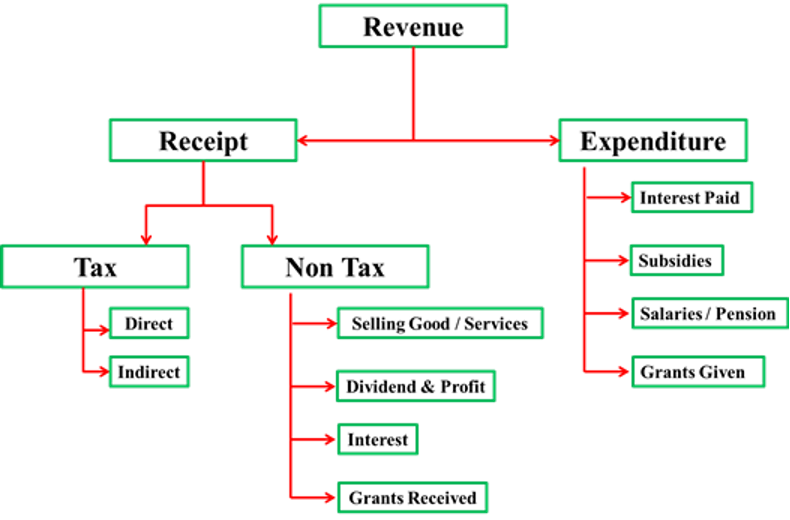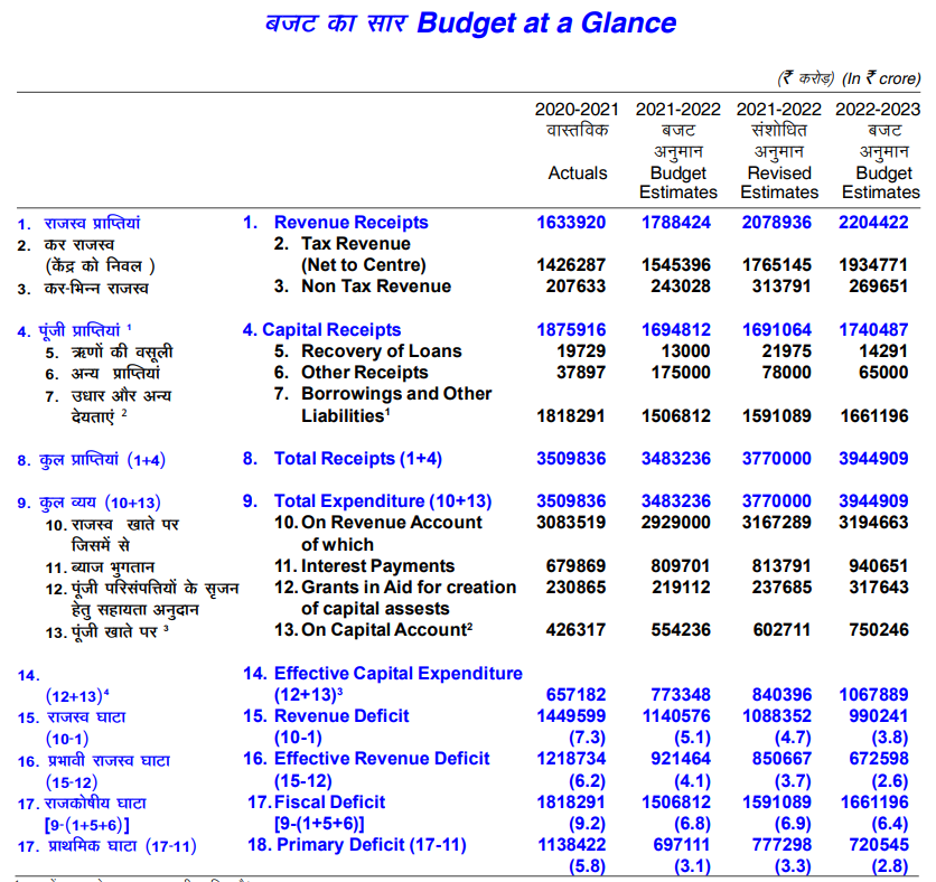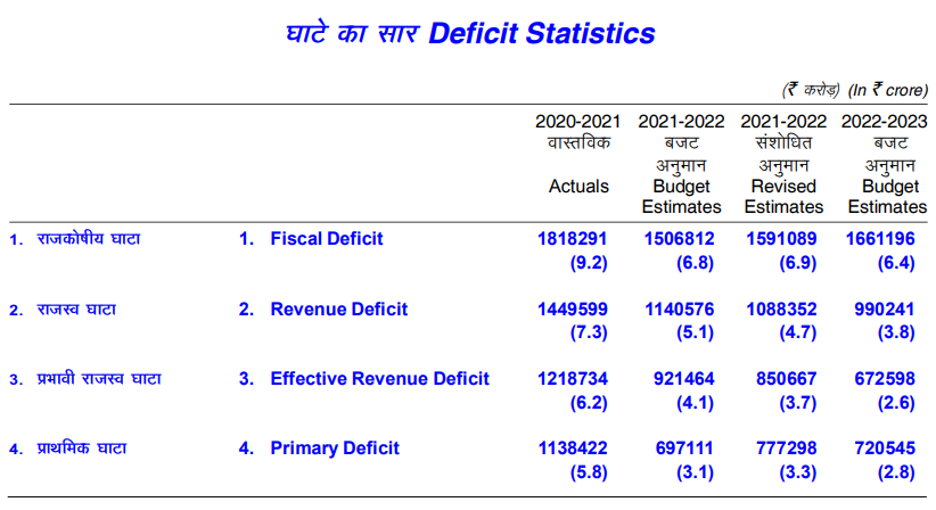Syllabus- Public Finance: Tax structure, Central and state taxes; Government expenditure in revenue and capital account; Public debt: composition- internal and external debt.
Number of questions- Mains: 02, Prelims – 10
Mains Questions of the day-
1.Mention the components of Revenue Budget quoting the budget 2022-23 figures.
Introduction:
Write briefly about Budget
Body:
Mention the components of Revenue budget.
Conclusion:
Content:
GOVERNMENT BUDGET AND ITS COMPONENTS: –
- There is a constitutional requirement Article (112) to present before the Parliament a statement of estimated receipts and expenditures of the government in respect of every financial year.
- Budget has two accounts-
- those that relate to the current financial year only are included in the revenue account (also called revenue budget) and
- those that concern the assets and liabilities of the government into the capital account (also called capital budget).
Classification of Revenue Budget:
Classification of Revenue Budget in to two categories:
- Revenue Receipts
- Revenue Expenditure

The following are the main objectives of Revenue Budget:
- Reallocation of resources:
It helps to distribute resources, keeping in view the social and economic advantages of the country.
- Allowance or Tax concessions:
The government gives allowance and tax concessions to corporate entities and manufacturers to encourage investment.
- Welfare of the people:
The government can give subsidies to farmers and the poor for their welfare.
- Minimise the inequalities in income and wealth:
- In an economic system, income and wealth inequality is an integral part.
- So, the government aims to bring equality by imposing a tax on the elite class and spending extra on the well-being of the poor.
- Decrease regional differences:
It aims to diminish regional inequalities by implementing taxation and expenditure policy and promoting the installation of production units in underdeveloped regions.
Revenue Receipts:
- Revenue receipts are those receipts that do not lead to a claim on the government.
- They are termed non-redeemable.
- They are divided into:
- Tax and
- Non-tax revenues.
- Tax revenues:
An important component of revenue receipts, have for long been divided into
- Direct taxes (personal income tax and firms (corporation tax)), and
- Indirect taxes like
- Excise taxes (duties levied on goods produced within the country),
- Customs duties (taxes imposed on goods imported into and exported out of India) and
- GST (service Tax).
- The redistribution objective is sought to be achieved through progressive income taxation, in which higher the income, higher is the tax rate.
- Firms are taxed on a proportional basis, where the tax rate is a particular proportion of profits.
- With respect to excise taxes:
- Necessities of life are exempted or taxed at low rates,
- Comforts and semi-luxuries are moderately taxed, and
- Luxuries, tobacco and petroleum products are taxed heavily.
- Non-tax revenue of the central government:
It mainly consists of:
- Interest receipts(receives) on account of loans by the central government
- Dividends and profits on investments made by the government
- Fees and other receipts for services rendered by the government.
- Cash grants-in-aid from foreign countries and international organisations are also included.
- The estimates of revenue receipts take into account the effects of tax proposals made in the Finance Bill.
Revenue Expenditure:
- Revenue Expenditure is expenditure incurred for purposes other than the creation of physical or financial assets of the central government.
- It relates to those expenses incurred for:
- The normal functioning of the government departments and various services
- Interest payments on debt incurred by the government and
- Grants given to state governments and other parties (even though some of the grants may be meant for creation of assets).
- Revenue expenditure relates to:
- Central Plans
- Central assistance for State and Union Territory plans.
- Interest payments
- Defence service,
- Subsidies
- Salaries and
- Pensions.
- Interest payments on market loans, external loans and from various reserve funds constitute the single largest component of revenue expenditure.
- Defence expenditure, is committed expenditure in the sense that given the national security concerns, there exists little scope for drastic reduction.
- Subsidies are an important policy instrument which aim at increasing welfare.
- Apart from providing implicit subsidies through under-pricing of public goods and services like education and health, the government also extends subsidies explicitly on items such as exports, interest on loans, food and fertilisers.

2. Discuss various types of deficits presented under the budget.
Introduction:
What is deficit? Mention the major types.
Body:
Discuss the types of deficits.
Conclusion:
Deficits are necessary for a developing country but fiscal consolidation is must for an economy.
Content:
Deficit is the amount by which the spending done in a budget surpass the earnings.
Revenue deficit
A revenue deficit refers to the surplus of the government’s revenue expenditure over the revenue receipts.
Revenue deficit = Revenue expenditure – Revenue receipts
This deficit only incorporates current income and current expenses. A high degree of deficit symbolises that the government should reduce its expenses. The government may raise its revenue receipts by raising income tax. Disinvestment and selling off assets is another corrective measure to minimise a revenue deficit.
Effective Revenue Deficit-
Effective revenue deficit refers to the difference between fiscal deficit and grants for the creation of capital assets. Effective revenue deficit signifies the number of capital receipts that are being used for actual consumption expenditure of the government. This concept was introduced in the Union Budget 2011-12.
Fiscal deficit
A fiscal deficit is the distinction between the government’s total expenditure and its total receipts, which excludes borrowing.
Gross fiscal deficit = Total expenditure – (Revenue receipts + Non-debt creating capital receipts)
A fiscal deficit has to be financed by borrowing. Hence, it includes the total borrowing necessities of the government from all the possible sources. From the financing part,
Gross fiscal deficit = Net borrowing at home + Borrowing from RBI + Borrowing from abroad
Primary deficit
A primary deficit is the amount of money that the government requires to borrow from the interest payments on the formerly borrowed loans. We must take a note that the borrowing necessity of the government comprises interest responsibilities on the collected amount of debt. The aim of quantifying the primary deficit is to concentrate on current fiscal imbalances. To attain an approximate borrowing on account of current expenses overreaching revenues, we need to compute what has been known as the primary deficit. It is the fiscal deficit, the interest payments.
Gross primary deficit = Gross fiscal deficit – Net interest liabilities
Net interest liabilities comprise interest payments – interest receipts by the government on the net domestic lending.

Prelims Questions of the day:
1.Subsidies of the government come under which of the following component of the Government Budget?
- Revenue expenditure
- Capital Expenditure
- Revenue Receipts
- Capital Receipts
Answer: A
Explanation:
- Revenue Expenditure is the expenditure by the government which does not impact its assets or liabilities.
- For example, this includes salaries, subsidies, interest payments, pension, and administrative expenses.
2. Grants to given by the center to the states come under?
- Capital Expenditure
- Revenue Expenditure
- Capital Receipts
- Revenue Receipts
Answer: B
Explanation:
- Broadly, the expenditure which does not result in creation of assets for Government of India is treated as revenue expenditure.
- All grants given to State Governments/Union Territories and other parties are also treated as revenue expenditure even though some of the grants may be used for creation of assets.
3.Loans taken by the Central Government come under?
- Capital Expenditure
- Revenue Expenditure
- Revenue Receipts
- Capital Receipts
Answer: D
Explanation:
- Loans from public, foreign governments and RBI form a major part of the government’s capital receipts.
- Capital expenditure is the expenditure on development of machinery, equipment, building, health facilities, education etc.
4. Which of the following represents the tax on value of Goods?
- Advalorem Tax
- Value Added Tax
- Customs Duty
- Trade Tax
Answer: A
Explanation:
- Advalorem tax, any tax imposed on the basis of the monetary value of the taxed item.
- Literally the term means “according to value.”
- Traditionally, most customs and excises had “specific” rates; the tax base was defined in terms of physical units such as gallons, pounds, or individual items.
5. Interest payments on loans were taken by the Centre come under?
- Capital Expenditure
- Revenue expenditure
- Capital Receipts
- Revenue Receipts
Answer: B
Explanation:
- Revenue expenditure is for the normal running of Government departments and various services, interest payments on debt, subsidies, etc.
- Broadly the expenditure which does not result in creation of assets for Government of India is treated as revenue expenditure.
6.Which among the following is the biggest source of revenue for the Government in FY22?
- Corporation tax
- GST
- Income tax
- Excise duty
Answer: B
Explanation:
- Tax is one of the major sources of revenue for the government to carry out its work. Tax revenue can be classified into a few major categories — Corporation tax, tax on income, Customs Tax, Union excise duties, service tax, and several others.
- GST tax (16%) is the biggest source of revenue for the government in FY2022.
7. Taxation policies affect which of the following components in the Indian economy?
1. Level of domestic investment
2. Foreign investment
3. Savings
4. Inflation
Select the correct answer using the codes below.
A. 1 and 3 only B. 2, 3 and 4 only
C. 1and 4 only D. 1, 2, 3 and 4
Answer: D
Explanation-
Tweaking taxes affect the level of savings in the economy. Savings affect investment.
Foreign investments will be affected negatively if corporation and service taxes are very high in the country. However, investor friendly tax policies such as GST will attract greater domestic as well as foreign investment. So, 1, 2 and 3 are correct.
Increasing taxes in the country will lead to lower disposable income and lesser demand thus being counter-inflationary. So, 4 is correct.
8. Public finance aims at which of the following objectives?
A. Allocating resources
B. Redistributing resources
C. Stabilising national income and employment
D. All the above
Answer: D
Explanation-
First, certain goods, referred to as public goods (such as national defense, roads, government administration), as distinct from private goods (like clothes, cars, food items), cannot be provided through the market mechanism, i.e. by transactions between individual consumers and producers and must be provided by the government. This is the allocation function.
Second, through its tax and expenditure policy, the government attempts to bring about a distribution of income that is considered ‘fair’ by society. The government affects the personal disposable income of households by making transfer payments and collecting taxes and, therefore, can alter the income distribution. This is the distribution function.
Third, the economy tends to be subject to substantial fluctuations and may suffer from prolonged periods of unemployment or inflation.The overall level of employment and prices in the economy depends upon the level of aggregate demand which is a function of the spending decisions of millions of private economic agents apart from the government.
9. The exercise of Gender Budgeting usually involves which of these activities in India?
A. Special initiatives for empowering women
B. Examination of the utilisation of resources allocated for women
C. Impact of public expenditure and policies of the government on women
D. All the above
Answer: D
Explanation-
GB entails dissection of the Government budgets to establish its gender differential impacts and to ensure that gender commitments are translated in to budgetary commitments.
Gender Budgeting Cells (GBCs) in Union Government are envisaged to serve as focal points for coordinating gender budgeting initiatives within their Ministries and across Departments. So far 56 Ministries/Department have confirmed setting up of a cell/nominating a nodal person.
10. Fiscal deficit is the difference between
A. Government’s total expenditure and its total receipts excluding borrowing
B. Government’s total revenue expenditure and its revenue receipts excluding borrowing
C. Government’s planned expenditure and its total receipts
D. Government’s total expenditure and its total receipts including borrowing
Answer: A
Explanation-
Gross fiscal deficit = Total expenditure – (Revenue receipts + Non debt creating capital receipts)
Non-debt creating capital receipts are those receipts which are not borrowings and, therefore, do not give rise to debt. Examples are recovery of loans and the proceeds from the sale of PSUs.
